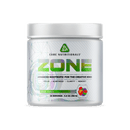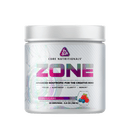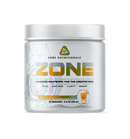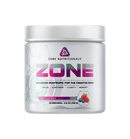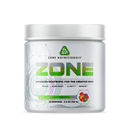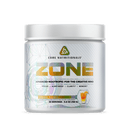Product Description
Researchers call it the “flow state” – “the mental state in which a person performing some activity is fully immersed in a feeling of energized focus, full involvement, and enjoyment in the process of the activity.” More commonly, and simply, it is known as being in the “zone.” Everyone knows the feeling: eyes narrow, breath becomes deep, time passes quickly, and the world fades away as you focus on the only thing that matters at that moment. What if you could bottle that feeling? Would you?
Well, we did. Core ZONE represents the pinnacle in nootropic supplementation. Custom-built to get, and keep you, in the zone. Our formula addresses major pathways of cognition and focus with key ingredients at or above clinical serving sizes. Ingredients like ALCAR increase the production of key neurotransmitters involved in producing the flow state, such as serotonin and dopamine – while others such as Bacopa monnieri and NeuroFactor® have been demonstrated in clinical trials to reduce cognitive inhibition, increase working memory, and increase performance on cognitive tasks. In other words, that zoned-in feeling you love bottled and ready for your use whenever you need it.
This is not another stim-heavy, kitchen-sink formula with something for everyone and nothing for you. No. It is purpose-built, surgically-targeting the cognitive pathways that benefit you most – when you need them the most. So get Core ZONE and get in the zone.
Acetyl-l-Carnitine:
L-carnitine is a derivative of the amino acid lysine and, as certain conditions outpace the body’s ability to produce it, l-carnitine is considered a conditionally essential amino acid. While endogenous biosynthesis of l-carnitine from the amino acids lysine and methionine is sufficient for essential processes – along with dietary sources of carnitine from protein-rich red meat, for example – dietary supplementation of carnitine may pose benefits in certain physiological conditions. Unfortunately, due to excess metabolism of l-carnitine by microorganisms in the small intestine, exogenous supplementation with oral l-carnitine has proved ineffective. ALCAR, an acetylated version of l-carnitine, has considerably higher oral bioavailability, due likely to only partial hydrolytic metabolism. Once in the bloodstream, ALCAR plays a fundamental role in the production of energy, acting as the catalyst for the beta-oxidation of long chain fatty acids by the mitochondria; regulating the CoA to Acyl-CoA ratio (necessary for the production of ATP); and the metabolism of carbohydrates. ALCAR also is an excitatory agent for neurons, increases neuronal transmission, and increases the production of neurotransmitters and neurohormones such as dopamine and serotonin.
Tyrosine is amongst a class of amino acids known as ‘non-essential’ amino acids, so called because the body can produce them endogenously, and it is therefore not essential to consume dietary tyrosine. That said, tyrosine is also what is known as a conditionally-essential amino acid; conditionally-essential because, along with glucose and ammonia, the synthesis of tyrosine additionally requires adequate levels of phenylalanine. Once synthesized, tyrosine is one of the most critical amino acids, given its prominent role as a substrate in the synthesis of the catecholamines dopamine, norepinephrine, and epinephrine, in addition to both T3 (triiodothyronine) and T4 (thyroxine) thyroid hormones.
In studies on stress modulation, tyrosine has been demonstrated to reverse stress-induced norepinephrine depletion and the depressant-behavioral effects normally associated with it. In simpler terms, tyrosine may, in certain conditions, dampen the extent to which norepinephrine is removed from the bloodstream during a stress event. In simpler terms still, tyrosine may help to mitigate the sense of depletion and fatigue felt at the end of a workout.
Tyrosine may also play important metabolic functions, mostly related to its role in synthesizing compounds which stimulate the nervous system. While not traditionally considered a sympathomimetic amine, studies which have co-administered tyrosine and stimulants demonstrate a synergistic effect. These studies suggest that tyrosine may potentiate the effects of both endogenous and supplemental norepinephrine and its mimetics (in the case of exogenous use) with respect to lipolysis, thermogenesis, and energy expenditure. Meaning that tyrosine may play a role in assisting norepinephrine to break up triglycerides and increase body heat transiently.
Taurine:
Through traditionally referred to as an amino acid due to its chemical structure, taurine is not an amino acid in the sense that leucine, alanine, or glutamine are. Its chemical status aside, taurine is considered one of the body’s most essential chemical compounds, as cardiovascular function, muscle development and function, along with optical and nervous systems in the body depend on its abundance. While data on taurine typically occurs with taurine in supplement combinations (with caffeine and other amino acids), these data nevertheless suggest that dietary supplementation with taurine may have beneficial effects on mental focus and alertness and may assist during times of increased physical exertion.
Citicoline (Cytidine 5’-diphosphocholine):
Choline is an essential nutrient involved in numerous metabolic pathways, including DNA regulation and repair, protein function, and metabolism. Perhaps most importantly, the critical neurotransmitter acetylcholine is produced directly from free choline via cholinergic neurons. Acetylcholine is then responsible for a number of functions itself, most crucially as the compound which induces muscular contraction, and as the neuromodulator partially responsible for modulating risk/reward, arousal, and enhancing memory.
Choline’s essential role as a substrate for acetylcholine, and therefore brain development, is well documented in animal models. These studies demonstrate that levels of free maternal choline have a direct and fundamental impact on prenatal brain development, with the enhancements or deficits lasting into adulthood. Choline’s enhancing effect is particularly prominent in the hippocampus. In humans, the hippocampus is primarily involved in the consolidation of memory (taking short, episodic memory and translating it into long-term memory) and the learning of new information. Acetylcholine is a critical component in these processes, as mentioned above, and choline may therefore play a potential role in these processes as well by providing the substrate for acetylcholine synthesis.
Citicoline (Cytidine 5’-diphosphocoline), also known as CDP-choline, is a potentially superior form of choline due to its ability to cross the blood brain barrier. In fact, most studies with neurological or nootropic effects used this form. In that regard, studies in otherwise healthy, normal adults demonstrated meaningful and statistically significant impacts on working memory, recall, and attention.
Mucuna pruriens:
Mucuna pruriens is one of the popular medicinal plants of India and is known to contain various beneficial nutritional compounds. The main nutrient found in Mucuna pruriens is L-dopa, which acts as a natural source of dopamine. Prolactin is a hormone released by the pituitary gland, which is believed to exert anti-androgenic effects in men. Mucuna pruriens’ ability to support healthy dopamine levels may significantly reduce the release of prolactin hormone by the pituitary glands offering powerful benefits. In addition, clinical evidence suggests that Mucuna pruriens not only supports healthy growth hormone levels but also contains naturally occurring serotonin precursors to support mood, memory, and overall well-being. Clinically shown to support optimal balance of growth hormone, prolactin, serotonin and other beneficial hormones, Mucuna pruriens may also assist healthy weight management and stress support.
Bacopa monnieri:
Bacopa monnieri, also known as the water hyssop commonly, or as Brahmi in Ayurvedic texts, is a small creeping herb endemic to sub-tropical India. The herb has been used in traditional Indian medicine for well over one thousand years, with its first recorded usage coming in the 6th century A.D. In this traditional context, BM has been used for a wide-range of purposes, including as a treatment of asthma and epilepsy.
More recently, BM has been the subject of numerous cognition and memory trials, as the plant has a well-established nootropic effect. Likely through modulation of the serotonin reuptake system, clinical trials in healthy humans have demonstrated that BM possesses a significant effect on the retention of newly-learned information. In several trials utilizing a 300mg daily serving, BM was also shown to decrease the recall delay of newly learned information and reduce short term forgetfulness – suggesting that the herb’s effect on the serotonic and cholinergic systems are increasing the encoding (the literal storing) of memory information.
Beyond cognition and memory encoding, BM has also been demonstrated to function as a potent adaptogen and relaxant – which in the Core ZONE formula may help to smooth the effect curve of the product’s stimulants, reducing jitteriness or, “crash.”
Caffeine Anhydrous:
Caffeine is one of the most widely consumed, and perhaps one of the most reviewed, psychoactive compounds. Its physiological effects in a range of areas have been well-documented, including exercise performance, information processing, alertness and mood enhancement, attention, and awareness, along with its anti-lipogenic and lipolytic abilities.
Most importantly to Core ZONE, caffeine has been shown to have significant effects on daily performance where energy is needed, even with ingestion in servings as small 3 to 9mg/kg/bw/day (the equivalent of 2 cups of standard coffee, for a 170lb male). One study in particular looked at the effects of caffeine on sleep deprived and heavily fatigued military personnel, a job where alertness and attention are extremely important, and found that caffeine did possess positive benefits on these attributes. The study concluded that:
- Caffeine has a positive effect on reaction time and attention during psychomotor tasks. This can also include driving or computer related tasks.
- Mood and alertness are positively affected by caffeine in doses between 75mg and 300mg.
- Caffeine has a low toxicity and produces no serious physiological side effects in adults.
When it comes to exercise, possible explanations for caffeine’s performance-enhancing effects lie in its metabolic effects on both lean and fat tissue. It is suggested that caffeine’s potent lipolytic (the breakdown of fat tissue into fatty acids) and oxidative (the actual ‘burning’ of fat) action allow the body to utilize these sources during prolonged submaximal exercise. As a consequence, muscle glycogen is spared and available for use later in the training session. Practically speaking, this means caffeine is forcing your body to preferentially use fat tissue as a fuel source, while sparing the glycogen which gives you the full-bodied look!
In short-term exercise, caffeine’s demonstrated role in the inhibition of cyclic AMP- phosphodiesterases (PDE), adenosine receptor antagonism, and adrenoreceptor agonism come into play. These three pathways collectively stimulate lipolytic activity, boost fat metabolism, increase metabolic rate and energy expenditure, and regulate the body’s thermogenic activity. The practical results of activating these pathways are increases to the contractile force of both cardiac and skeletal muscle (harder flexion), an increase in energy expenditure (freeing up more caloric energy to be used in contraction), dilation of vasculature (better blood flow), and improvements to both nitrogen retention and skeletal muscle protein synthesis (key components to muscle building).
In Core ZONE, we have included a per-serving amount of caffeine that is neither excessive, nor arbitrary, but that instead reflects the servings used in clinical research to give such benefits that can be useful wherever heightened focus and energy are needed.
NeuroFactor®:
Neurofactor®, an extract derived from the whole fruit Coffea arabica plant, is a clinically proven ingredient shown to stimulate the production of the neuroprotein, Brain-Derived Neurotrophic Factor (BDNF). BDNF has been shown to be crucial in the development, maintenance and repair of neurons and also protect against neuro-degenertion. One study comparing other coffee, caffeine, and polyphenol compounds, showed that they were not statistically significant in increasing BDNF % compared to NeuroFactor®. The unique polyphenol profile found in NeuroFactor® showed to be superior in increasing BDNF concentration.
Huperzia serrata Extract (leaf and stem) (1% Huperzine A):
Huperzia serrata is a compound found in the plant families of Huperziaceae, Lycopodiaceae, and Selaginella and is endemic to China. The Lycopodium alkaloid Huperizine-A, found in Core ZONE, was first isolated from a folk medicinal preparation in 1984.
Due to the potent anticholinesterase activities of Huperzine A, the compound was been evaluated in numerous in vitro, in vivo, and human trials. These data suggest that Huperzine’s Ache activities are most potent in the cortex, hippocampus, and striatum (at least in rats) – key regions in the brain responsible for forming, coordinating, and recalling memory. These effects are assisted by Huperzine A’s high oral bioavailability. Studies using microdialysis technique in rats, for example, showed that the response to Huperzine A was dose-dependent and substantially lowered the level of ACh in cortex.
Huperzine A has also shown promise in humans. Used as a reversible inhibitor of acetylcholinesterase, Huperzine A has shown positive benefits on cognition and as a therapy for individuals suffering from Alzheimer’s Disease. This is partly due to its inhibitory factors on acetylcholine but also its neuroprotective properties. In another study on memory and learning performance, 34 pairs of middle school students complaining of memory inadequacy were given a small dose of Huperzine A. The students were then match paired along a number of vectors and provided tests on working memory. The results of this study exhibited that HupA markedly improved the memory function of adolescent students
Pregnenolone:
Pregnenolone, or pregn-5-en-3β-ol-20-one, is known as the grandmother hormone due to its precursor role in the endogenous biosynthesis of most steroid hormones. Pregnenolone also has potent intrinsic activity, however, functioning as a neurosteroid. In that capacity, pregnenolone has been investigated as a mechanistically novel agent for treating cognitive and behavioral symptoms associated with schizophrenia and other mood disorders.
Pregnenolone has been demonstrated to enhance learning and memory in animal models at physiologically relevant concentrations. For example, acute administration of pregnenolone or pregnenolone sulfate to rodents’ results in increased performance along several standardized tests – including maze tests given to rodents to test working memory. Additionally, pregnenolone appears to prevent learning and memory deficits induced by NDMA receptor agonists. These results suggest that pregnenolone’s cognitive functions are at least partially explained by modulating the NMDA receptors – critical receptors involved in numerous neurological processes.
Statements made on this website have not been evaluated by the U.S. Food and Drug Administration. These products are not intended to diagnose, treat, cure or prevent any disease. Information provided by this website or this company is not a substitute for individual medical advice.
Payment & Security
Your payment information is processed securely. We do not store credit card details nor have access to your credit card information.
Disclaimer
Product reviews are provided for informational purposes only and reflect solely the views and opinions expressed by the contributors and not those of the Planet Supplements. Planet Supplements does not verify or endorse any claims made in these reviews. Please read the full product reviews disclaimer. All online offers and prices are valid for online purchases only and may be different from those in our retail stores. The products and the claims made about specific products on or through this site have not been evaluated by the United States Food and Drug Administration (FDA) and are not intended to diagnose, treat, cure or prevent disease. The information provided on this site is for informational purposes only and is not intended as a substitute for advice from your physician or other health care professional or any information contained on or in any product label or packaging. You should not use the information on this site for diagnosis or treatment of any health problem or for prescription of any medication or other treatment. You should consult with a healthcare professional before starting any diet, exercise or supplementation program, before taking any medication, or if you have or suspect you might have a health problem. Please view our full Terms of Use Agreement for more information and the terms and conditions governing your use of this site.








